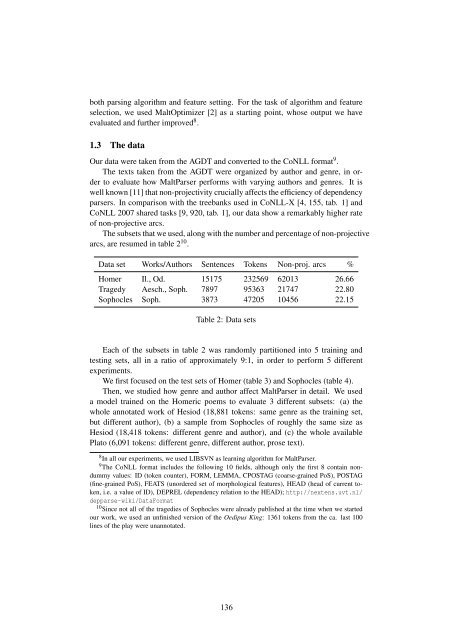A Treebank-based Investigation of IPP-triggering Verbs in Dutch
A Treebank-based Investigation of IPP-triggering Verbs in Dutch
A Treebank-based Investigation of IPP-triggering Verbs in Dutch
You also want an ePaper? Increase the reach of your titles
YUMPU automatically turns print PDFs into web optimized ePapers that Google loves.
oth pars<strong>in</strong>g algorithm and feature sett<strong>in</strong>g. For the task <strong>of</strong> algorithm and feature<br />
selection, we used MaltOptimizer [2] as a start<strong>in</strong>g po<strong>in</strong>t, whose output we have<br />
evaluated and further improved 8 .<br />
1.3 The data<br />
Our data were taken from the AGDT and converted to the CoNLL format 9 .<br />
The texts taken from the AGDT were organized by author and genre, <strong>in</strong> order<br />
to evaluate how MaltParser performs with vary<strong>in</strong>g authors and genres. It is<br />
well known [11] that non-projectivity crucially affects the efficiency <strong>of</strong> dependency<br />
parsers. In comparison with the treebanks used <strong>in</strong> CoNLL-X [4, 155, tab. 1] and<br />
CoNLL 2007 shared tasks [9, 920, tab. 1], our data show a remarkably higher rate<br />
<strong>of</strong> non-projective arcs.<br />
The subsets that we used, along with the number and percentage <strong>of</strong> non-projective<br />
arcs, are resumed <strong>in</strong> table 2 10 .<br />
Data set Works/Authors Sentences Tokens Non-proj. arcs %<br />
Homer Il., Od. 15175 232569 62013 26.66<br />
Tragedy Aesch., Soph. 7897 95363 21747 22.80<br />
Sophocles Soph. 3873 47205 10456 22.15<br />
Table 2: Data sets<br />
Each <strong>of</strong> the subsets <strong>in</strong> table 2 was randomly partitioned <strong>in</strong>to 5 tra<strong>in</strong><strong>in</strong>g and<br />
test<strong>in</strong>g sets, all <strong>in</strong> a ratio <strong>of</strong> approximately 9:1, <strong>in</strong> order to perform 5 different<br />
experiments.<br />
We first focused on the test sets <strong>of</strong> Homer (table 3) and Sophocles (table 4).<br />
Then, we studied how genre and author affect MaltParser <strong>in</strong> detail. We used<br />
a model tra<strong>in</strong>ed on the Homeric poems to evaluate 3 different subsets: (a) the<br />
whole annotated work <strong>of</strong> Hesiod (18,881 tokens: same genre as the tra<strong>in</strong><strong>in</strong>g set,<br />
but different author), (b) a sample from Sophocles <strong>of</strong> roughly the same size as<br />
Hesiod (18,418 tokens: different genre and author), and (c) the whole available<br />
Plato (6,091 tokens: different genre, different author, prose text).<br />
8 In all our experiments, we used LIBSVN as learn<strong>in</strong>g algorithm for MaltParser.<br />
9 The CoNLL format <strong>in</strong>cludes the follow<strong>in</strong>g 10 fields, although only the first 8 conta<strong>in</strong> nondummy<br />
values: ID (token counter), FORM, LEMMA, CPOSTAG (coarse-gra<strong>in</strong>ed PoS), POSTAG<br />
(f<strong>in</strong>e-gra<strong>in</strong>ed PoS), FEATS (unordered set <strong>of</strong> morphological features), HEAD (head <strong>of</strong> current token,<br />
i.e. a value <strong>of</strong> ID), DEPREL (dependency relation to the HEAD); http://nextens.uvt.nl/<br />
depparse-wiki/DataFormat<br />
10 S<strong>in</strong>ce not all <strong>of</strong> the tragedies <strong>of</strong> Sophocles were already published at the time when we started<br />
our work, we used an unf<strong>in</strong>ished version <strong>of</strong> the Oedipus K<strong>in</strong>g: 1361 tokens from the ca. last 100<br />
l<strong>in</strong>es <strong>of</strong> the play were unannotated.<br />
136
















